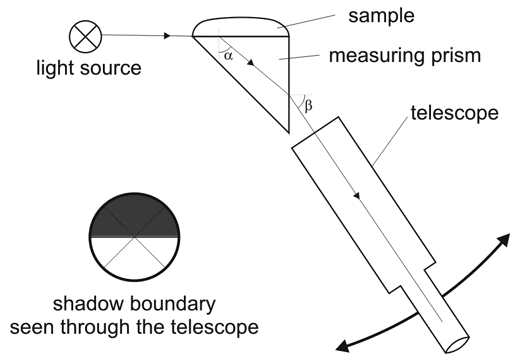Pulfrich refractometer
Pulfrich refractometer is the second design (after Abbé refractometer) that became commercially avilable in 19th century. It is another type of critical angle refractometer. Unfortunately, probably because it is rarely used and much less common in labs, people tend to call every refractometer that is different from Abbé design "Pulfrich refractometer" - in effect you will commonly see many types of refractometers (like V block cell refractometer) named "Pulfrich", in most cases without any reason.

Pulfrich refractometer.
This description of the instrument was published in the early 20th century in the Arthur H. Thomas Company catalogue:
A glass prism of high refractive index has two plane polished faces, which are perpendicular to one another, and is so placed that one of these is vertical and the other horizontal. The substance whose refractive index is required is placed upon the horizontal surface, and in the case of a liquid is contained in a glass cell cemented to the prism so as to contain that face. A beam of monochromatic light is directed almost horizontally through the substance so that it meets the prism face at grazing incidence. the emergent beam is bounded sharply by the ray which actually grazes the prism surface, and the sharp boundary is observed with a telescope attached to a divided circle. On this circle, whose axis of rotation is horizontal, the angle of emergence of the beam from the vertical prism face can be read to one minute, witch the aid of a vernier. For making measurements of dispersion a clam and a micrometer are provided, the smallest division on the drumhead of the micrometer screw corresponding to 6 seconds of arc. A condensing lens and supporting rod for vacuum tube form part of the apparatus. A small reflecting prism us also provided so that another source of light, e.g., a sodium flame, is easily interchangeable with the vacuum tube.
A special feature of the instrument is the increased effectiveness in the temperature control as compared with that to be found in previous designs. the hollow metal water jacket surrounding the prism is provided with a top cover with is itself of hollow metal. These two are connected in train with the thermometer jacket which dips into the cell for liquids. The prism and the substance experimented upon are thus completely jacketed with the exception of the vertical prism face from which the light emerges, and a small rectangular aperture by which the light enters the prism. The temperature can thus be maintained very constant by pumping a stream of water at constant temperature through the system described.
Pulfrich designed his refractometer before 1888, as at this date his design was first published. Initially the instrument was sold by Max Wolz in Bonn. Around 1985 Pulfrich joined Carl Zeiss factory and modified initial design.


